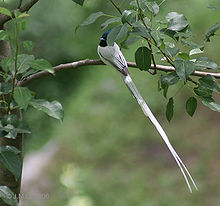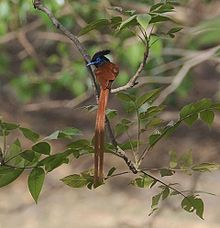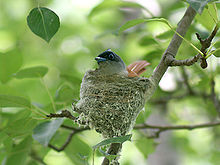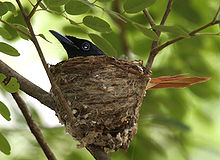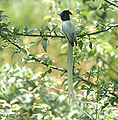- Asian Paradise-flycatcher
-
Asian Paradise Flycatcher 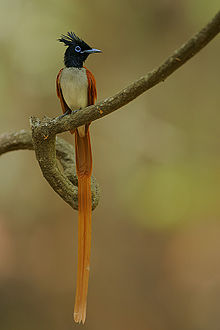
Adult male in Sri Lanka Conservation status Scientific classification Kingdom: Animalia Phylum: Chordata Class: Aves Order: Passeriformes Family: Monarchidae Genus: Terpsiphone Species: T. paradisi Binomial name Terpsiphone paradisi
(Linnaeus, 1758)Synonyms Tchitrea paradisi
The Asian Paradise-flycatcher (Terpsiphone paradisi) is a medium-sized passerine bird native to Asia. Males have elongated central tail feathers, and in some populations a black and rufous plumage while others have white plumage. Females are short-tailed with rufous wings and a black head. They feed on insects, which they capture in the air often below a densely canopied tree.
With an extremely large range and a large population that appears to be stable, they have been evaluated as Least Concern by IUCN since 2004.[1]
In his first description of 1758, Carl von Linné nominated the species Corvus paradisi.[2] Paradise-flycatchers used to be classified with the Old World flycatcher family Muscicapidae, but are now placed in the family Monarchidae together with monarch flycatchers.[3][4]
Contents
Characteristics
Adult Asian Paradise-flycatchers are 19–22 cm (7.5–8.7 in) long. Their heads are glossy black with a black crown and crest, their black bill round and sturdy, their eyes black. Female are rufous on the back with a greyish throat and underparts. Their wings are 86–92 mm (3.4–3.6 in) long. Young males look very much like females but have a black throat and blue-ringed eyes. As adults they develop up to 24 cm (9.4 in) long tail feathers with two central tail feathers growing up to 30 cm (12 in) long drooping streamers.
Young males are rufous and have short tails. They acquire long tails in their second or third year. Adult males are either predominantly bright rufous above or predominantly white. Some specimens show some degree of intermediacy between rufous and white. Long-tailed rufous birds are generally devoid of shaft streaks on the wing and tail feathers, while in white birds the shaft streaks, and sometimes the edges of the wing and tail feathers are black.[5]
In the early 1960s, 680 long-tailed males were examined that are contained in collections of the British Museum of Natural History, Chicago Natural History Museum, Peabody Museum, Carnegie Museum, American Museum of Natural History, United States National Museum and Royal Ontario Museum. The specimens came from almost the entire range of the species, though some areas were poorly represented. The relative frequency of the rufous and white plumage types varies geographically. Rufous birds are rare in the extreme southeastern part of the species' range. Throughout the Indian area and, to a lesser extent, in China, asymmetrically patterned intermediates occur. Intermediates are rare or absent throughout the rest of the range of the species. In general, long-tailed males are[5]
- predominantly rufous with some white in wings and tail — collected in Turkestan, Kashmir, northern India, Punjab, Maharashtra, Sikkim and in Sri Lanka;
- predominantly rufous with some white in wings — collected in Iran, Afghanistan, Baluchistan, Punjab, Kashmir, northern and central India, Rajastan, Maharashtra, Bihar, Nepal;
- predominantly rufous with some white in tail — collected in Punjab, northern and central India, Calcutta, Sri Lanka and in the Upper Yangtse Valley in China;
- predominantly white with some rufous in tail and wings — collected in Kashmir, Maharashtra, Szechwan and North China;
- predominantly white with some rufous in tail — collected in Maharashtra and Foochow, China;
- predominantly white with back partly rufous — collected in Punjab and Madras;
- predominantly white with wings and tail irregularly blotched and washed with rufous in places — in the extreme southeastern edge of the range of the species : Alor Island and Sumba;
- moulting from rufous into white plumage — collected in North Bihar.
Possible interpretations of this phenomenon are : males may be polymorphic for rufous and white plumage colour; rufous birds may be sub-adults; and there may even be two sympatric species distinguishable only in the male.[5]
Habitat and distribution
Asian Paradise-flycatchers inhabit thick forests and well-wooded habitats from Turkestan to Manchuria, all over India and Sri Lanka to the Malay Archipelago on the islands of Sumba and Alor.[6] They are vagrant in Korea and Maldives, and regionally extinct in Singapore.[1]
They are migratory and spend the winter season in tropical Asia. There are resident populations in southern India and Sri Lanka, hence both visiting migrants and the locally breeding subspecies occur in these areas in winter.[7][8]
According to Linné’s first description Asian Paradise-flycatcher are distributed in India.[2] Later ornithologists observed this spectacular bird in other Asian countries, and based on differences in plumage of males described several subspecies, of which the following 14 are recognized today:[6]
- T. p. paradisi (Linnaeus, 1758) breeds in central and southern India, central Bangladesh and south-western Myanmar; populations occurring in Sri Lanka in the winter season are non-breeding.[9]
- T. p. leucogaster (Swainson, 1838) breeds in the western Tian Shan, in Afghanistan, in the north of Pakistan, in northwestern and central India, in Nepal’s western and central regions; populations occurring in the east of Pakistan and in the south of India migrate towards the foothills of the Himalayas in spring for breeding.[9]
- T. p. affinis (Blyth, 1846) inhabits Malaysia and Sumatra.
- T. p. incei (Gould, 1852) breeds in eastern, northeastern and central China, in the Russian Far East and in the north of Korea; populations occurring in Southeast Asia are non-breeding.
- T. p. insularis (Salvadori, 1887) inhabits the island Nias off the western coast of Sumatra.
- T. p. nicobarica (Oates, 1890) inhabits the Nicobar Islands.
- T. p. sumbaensis (Meyer, 1894) inhabits the Lesser Sunda Island Sumba.
- T. p. floris (Büttikofer, 1894) inhabits the Lesser Sunda Islands Sumbawa, Flores, Lomblen and Alor.
- T. p. procera (Richmond, 1903) inhabits the island Simeuluë northwest off the coast of Sumatra.
- T. p. ceylonensis (Zarudny & Harms, 1912) inhabits Sri Lanka.
- T. p. borneensis (Hartert, 1916) inhabits Borneo.
- T. p. saturatior (Salomonsen, 1933) breeds in the eastern parts of Nepal and northeastern India, in eastern Bangladesh and northern Myanmar; populations occurring in Malaysia migrate northward for breeding.[9]
- T. p. burmae (Salomonsen, 1933) inhabits the central region of Myanmar.
- T. p. indochinensis (Salomonsen, 1933) inhabits the eastern regions of Myanmar, Yunnan in the south of China, migrates through Thailand and Indochina to Malaysia, Sumatra and the neighboring islands.
Ecology and behaviour
Asian Paradise-flycatchers are noisy birds uttering sharp skreek calls. They have short legs and sit very upright whilst perched prominently, like a shrike. They are insectivorous and hunt in flight in the understorey. In the afternoons they dive from perches to bathe in small pools of water.
The breeding season lasts from May to July.[10] Being socially monogamous both male and female take part in nest-building, incubation, brooding and feeding of the young. The incubation period lasts 14 to 16 days and the nestling period 9 to 12 days.[11] Three or four eggs are laid in a neat cup nest made with twigs and spider webs on the end of a low branch.[9] The nest is sometimes built in the vicinity of a breeding pair of drongos, which keep predators away. Chicks hatch in about 21 to 23 days.[12] A case of interspecific feeding has been noted with Paradise Flycatcher chicks fed by Oriental White-eyes.[13]
Selected photos
-
Adult male in Kullu District of Himachal Pradesh, India.
-
Female in Kullu District of Himachal Pradesh, India.
References
- ^ a b c BirdLife International (2009). "Terpsiphone paradisi". IUCN Red List of Threatened Species. Version 2010.4. International Union for Conservation of Nature. http://www.iucnredlist.org/apps/redlist/details/146948.
- ^ a b Linnæus, C. (1758) Caroli Linnæi Systema naturæ per regna tria naturæ, secundum classes, ordines, genera, species, cum characteribus, differentiis, synonymis, locis. Editio decima, reformata. Holmiæ, Impensis Direct. Laurentii Salvii
- ^ Pasquet, É.; Cibois, A.; Baillon, F., Érard, C. (2002). "What are African monarchs (Aves, Passeriformes)? A phylogenetic analysis of mitochondrial genes". Comptes Rendus Biologies 325 (2): 107–118. doi:10.1016/S1631-0691(02)01409-9. PMID 11980172.
- ^ Lei Xin, Lian Zhen-Min, Lei Fu-Min, Yin Zuo-Hua, Zhao Hong-Feng (2007). "Phylogeny of some Muscicapinae birds based on cyt b mitochondrial gene sequences". Acta Zoologica Sinica 53 (1): 95.
- ^ a b c Owen, D. F. (1963). "The rufous and white forms of an Asiatic paradise flycatcher, Terpsiphone paradisi". Ardea 51: 230–236. http://ardeajournal.natuurinfo.nl/ardeapdf/a51-230-236.pdf.
- ^ a b Coates, B., Dutson, G., Filardi, C., Clement, P., Gregory, P., Moeliker, K. (2007). "Family Monarchidae (Monarch-flycatchers)". In del Hoyo, J., Elliott, A., Christie, D. A.. Handbook of the Birds of the World – Volume 11. Old World Flycatchers to Old World Warblers. Barcelona: Lynx Edicions. pp. 244–295. ISBN 84-96553-06-X.
- ^ Whistler, H. (1933). "The migration of the Paradise Flycatcher, (Tchitrea paradisi)". Journal of the Bombay Natural History Society 36 (2): 498–499.
- ^ Bates, R.S.P. (1932). "Migration of the Paradise Flycatcher Tchitrea paradisi". Journal of the Bombay Natural History Society 35 (4): 896–897.
- ^ a b c d Rasmussen, P.C, Anderton, J.C. (2005). Birds of South Asia: The Ripley Guide. Vol.2. Smithsonian Institution and Lynx Edicions. pp. 332–333.
- ^ Hume, A.O. (1890). The nests and eggs of Indian birds. Volume 2. R. H. Porter, London. pp. 22–26. http://www.archive.org/stream/nestseggsofindia02humerich#page/22/mode/2up.
- ^ Mizuta, Taku; Satoshi Yamagishi (1998). "Breeding biology of monogamous Asian Paradise Flycatcher Terpsiphone paradisi (Aves: Monarchinae): A special reference to colour dimorphism and exaggerated long tails in male". Raffles Bulletin of Zoology 46 (1): 101–112. http://rmbr.nus.edu.sg/rbz/biblio/46/46rbz101-112.pdf.
- ^ Rashid, SMA; Khan, A.; Ahmed, R. (1989). "Some observations on the breeding of Paradise Flycatcher, Terpsiphone paradisi (Linnaeus) (Monarchinae)". J. Bombay Nat. Hist. Soc. 86 (1): 103–105.
- ^ Tehsin, R.H.; Tehsin, H. (1998). "White-eye (Zosterops palpebrosa) feeding the chicks of Paradise Flycatcher (Terpsiphone paradisi)". J. Bombay Nat. Hist. Soc. 95 (2): 348.
Further reading
- Lewis, W.A.S. (1942) The Indian Paradise Flycatcher Tchitrea paradisi paradisi (Linn.). Some notes on a colony breeding near Calcutta. Journal of the Bengal Natural History Society 17 (1): 1–8.
- Inglis, C.M. (1942) The Indian Paradise Flycatcher Tchitrea paradisi paradisi (Linn.). Journal of the Bengal Natural History Society 17 (2): 50–52.
- Salomonsen, F. (1933). "Revision of the group Tchitrea affinis Blyth.". Ibis 75 (4): 730–745. doi:10.1111/j.1474-919X.1933.tb03360.x.
External links
Categories:- IUCN Red List least concern species
- Terpsiphone
- Birds of Nepal
- Birds of Pakistan
- Birds of Sri Lanka
- Birds of Bhutan
- Birds of India
- Birds of Bangladesh
Wikimedia Foundation. 2010.


